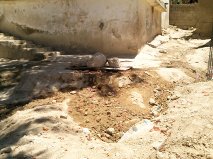Cesspits are sealed tanks that vary in shapes and sizes and have been used for over 100 years. Cesspits store liquid waste such as wastes from the showers and toilets; which are taken for disposal. Tanks are placed directly underground-because of ground conditions- with one manhole cover announcing their whereabouts. Cesspits should be cleared out and emptied on a daily basis to avoid problems. Leakage from the tank may cause pollution to land and water nearby.

The cesspit’s main purpose is to store the wastewater to separate oils, grease, solids and floating objects from the wastewater bacteria. After one or two days, the partially treated wastewater leaves the tank, exits the perforations, and enters the soil. Septic tanks are designed to accomplish two responsibilities: clarification and treatment. Clarification is a mission of water extraction method and held time, while treatment on the other hand involves biological treatment by anaerobic digestion.
In the past, redwood and steel were primarily used for septic tanks, but in modern days tanks are typically made from concrete, polyethylene, or fiberglass. Water-tightness is crucial for protecting the environment and should be tested before and after the tank is installed. Because cesspits are made to offer treatment and disposal of sewage, no non-biodegradable substances should be mixed with wastewater.
FoEME has identified the lack of a sewage system and poorly designed cesspits to be the major cause of pollution in Ghour. Concrete is used only on the sides of tanks, causing leakage of wastewater to the soil. The cesspits are also inadequately covered with plastic or colligated iron, which attracts insects and cause a very bad odor. Furthermore, covers insufficient to prevent an overflow of waste water into the surrounding area. FoEME is currently preparing briefs for sewage treatment plans for all of our Good Water Neighbors communities in Jordan to address the issue of inadequate cesspits and ensure cleaner water for our communities in the Jordan Valley.
This post was contributed by FoEME intern Hashem Al-Zubiedi. Hashem is based inFoEME’s Amman office.